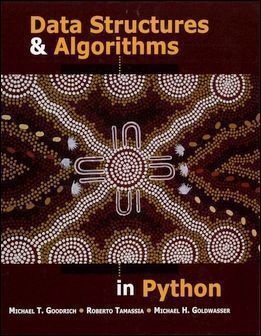Data Structures and Algorithms in Python
售價
$
2,100
- 一般書籍
- ISBN:9781118290279
- 作者:Michael T. Goodrich, Roberto Tamassia, Michael H. Goldwasser
- 版次:1
- 年份:2013
- 出版商:John Wiley
- 頁數/規格:768頁/精裝單色
- 參考網頁:Data Structures and Algorithms in Python
書籍介紹
本書特色
目錄
作者介紹
Description
Based on the authors’ market leading data structures books in Java and C++, this textbook offers a comprehensive, definitive introduction to data structures in Python by respected authors. Data Structures and Algorithms in Python is the first mainstream object-oriented book available for the Python data structures course. Designed to provide a comprehensive introduction to data structures and algorithms, including their design, analysis, and implementation, the text will maintain the same general structure as Data Structures and Algorithms in Java and Data Structures and Algorithms in C++.
Based on the authors’ market leading data structures books in Java and C++, this textbook offers a comprehensive, definitive introduction to data structures in Python by respected authors. Data Structures and Algorithms in Python is the first mainstream object-oriented book available for the Python data structures course. Designed to provide a comprehensive introduction to data structures and algorithms, including their design, analysis, and implementation, the text will maintain the same general structure as Data Structures and Algorithms in Java and Data Structures and Algorithms in C++.
Features
- A primer that reviews the basics of programming in Python (Chapter 1), followed by a separate introduction to object-oriented programming in Python (Chapter 2).
- Extensive coverage of recursion (Chapter 4).
- A chapter describing the array-based underpinnings of Python’s standard list, string, and tuple classes (Chapter 5), including both theoretical and empirical analyses of their efficiencies.
- Source code with complete implementations of the majority of data structures and algorithms described in the book; the code follows modern standards for Python 3, and makes use of the standard collections module.
- 500 illustrations that present data structures and algorithms in a clear, visual manner.
- More than 750 exercises, divided into categories of reinforcement, creativity, and projects.
Table of Contents
1. Python Primer
2. Object-Oriented Programming
3. Algorithm Analysis
4. Recursion
5. Array-Based Sequences
6. Stacks, Queues, and Deques
7. Linked Lists
8. Trees
9. Priority Queues
10. Maps, Hash Tables, and Skip Lists
11. Search Trees
12. Sorting and Selection
13. Text Processing
14. Graph Algorithms
15. Memory Management and B-Trees
A. Character Strings in Python
B. Useful Mathematical Facts
1. Python Primer
2. Object-Oriented Programming
3. Algorithm Analysis
4. Recursion
5. Array-Based Sequences
6. Stacks, Queues, and Deques
7. Linked Lists
8. Trees
9. Priority Queues
10. Maps, Hash Tables, and Skip Lists
11. Search Trees
12. Sorting and Selection
13. Text Processing
14. Graph Algorithms
15. Memory Management and B-Trees
A. Character Strings in Python
B. Useful Mathematical Facts
Michael Goodrich, PhD in Computer Science from Purdue University, 1987; Chancellor's Professor of Computer Science at University of California, Irvine; co-author (with Tamassia) of three other Wiley textbooks and a new computer security text, Addison Wesley, 2011.
Roberto Tamassia, PhD in Electrical and Computer Engineering from the University of Illinois at Urbana-Champaign, 1988; Plastech Professor of Computer Science and Chair of the CS Dept at Brown University; co-author with Goodrich, see texts above.
Michael Goldwasser, PhD in Computer Science from Stanford University, 1997; Associate Professor and Director of CS at St. Louis University; author of Object-Oriented Programming in Python, Pearson, 2008.
Roberto Tamassia, PhD in Electrical and Computer Engineering from the University of Illinois at Urbana-Champaign, 1988; Plastech Professor of Computer Science and Chair of the CS Dept at Brown University; co-author with Goodrich, see texts above.
Michael Goldwasser, PhD in Computer Science from Stanford University, 1997; Associate Professor and Director of CS at St. Louis University; author of Object-Oriented Programming in Python, Pearson, 2008.

